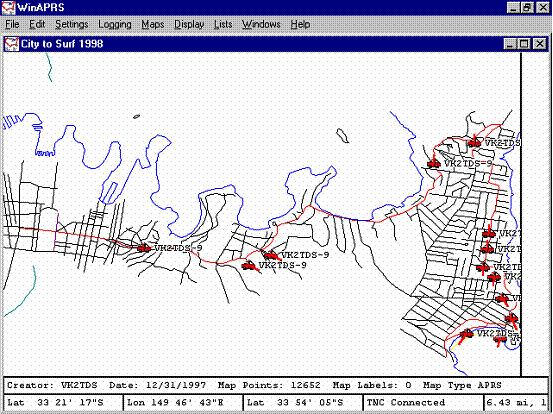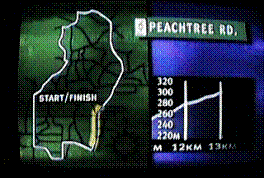1998 City 2 Surf
APRS goes in the 1998 Sun Herald City to Surf Race
By Darryl Smith, VK2TDS
Coming home one Sunday afternoon, I found a curious message on my answering machine. Kevin Dawson, VK2CKD had left a cryptic message about the Sydney City 2 Surf fun run, mentioning something about going in it. On returning the call I was told that we had just got permission to use APRS in the race, placing a ‘tracker’ on the lead vehicle. What I did not expect was being told that by that time next week the race would be over.
With fear and trepidation I told the WICEN team that I was prepared for the event. After all I had presented talks on APRS to about 15 groups over the previous 6 months. How could I not be ready?
During the past few months I had been preparing, hoping an event such as this would come up. I had been gradually putting the equipment I would need together. I had enough equipment to be able to track 2 vehicles, set up a repeater and be able to monitor the signal on my laptop (The Equipment I used is listed in the text box).
|
Tracker in Start Vehicle
The tracker in the start vehicle consisted of 25 Watt Yaesu FT-230R 2M Transmitter, Tiny-2 TNC updated EPROM’s, a mag mount Garmin GPS-30PC GPS, a mag mount 2m antenna and a 3 * 7AH gel-cell batteries. The transmitter, TNC and one battery were in a laptop bag. The other two batteries were in an old UPS case. Digipeater
The digipeater consisted of an old PK-88 with pre-APRS and pre-GPS EPROM’s, a 2 channel Motorola 2m 25W radio and a car battery. The antenna was Receiver
The receiver consisted of a kenwood TM-251 mobile, receiving only, a PicoPacket TNC, 25A power supply with 1.2AH of gel cells, connected to a NEC Laptop (colour, 100MHz 586). The antenna was the same |
As in any events such of this type there was no guarantee of any external power. That required me to be able to run everything from battery power.
As well as getting all the equipment set up I also needed to obtain maps for the area. This was both easier and harder than it sounds. Maps are available from public domain sources, but these needed to be digitised and calibrated for use. Luckily I had already done some work with AutoCad Lite and Visual Basic allowing me to simply get the maps out.
On the day of the race, I got up nice and early for the drive into Sydney. With some luck the weather was much better that the previous few days – where Sydney experienced a 1 in 100 year storm. Basically the weather was fine.
When people were assigned to stations, APRS was left out. That required me to scrounge for personnel. With luck, Michael Roll, a newer unlicensed member of the Waverley club was prepared to help me. It would agreed that he would travel with my mobile transmitter in the start vehicle to turn it off if anything went wrong. Michael was given a UHF scanner and mobile phone so that we could get him in that case.
Those wondering if this is legal, the answer is yes. I set up the station with no controls other than an external power switch. This clearly comes under the definition of an unattended packet station, even if it is mobile!)
|
APRS in the 1996 Atlanta Olympics
APRS was used in the 1996 Atlanta Olypmics
|
On the way to dropping him at the start, we needed to drop the digi-peater at the repeater site. This turned out to be a water tower in Vaucluse. Not wanting to see how the people setting this equipment up were going to lift the car battery for the repeater up the ladders I left them to it.
Then Mike and I went to the Start Line where the lead vehicle was stationed. Once we got there the driver had no idea that they were going to have additional equipment and a passenger. Some quick talking got the equipment loaded onto the 4-wheel drive. That was after telling them all about how APRS got into the Atlanta Olympic Games. After dropping off mike I then proceeded to the finish line where I was to set up the reciever.
There were a few hassles here. The first was attempting to get the TNC to receive any packets. This was solved by juggling the modular connections on the radio and the TNC. The other problem was a bit harder to fix – Attaching the antenna to the shed where the equipment was located. The problem was somewhat solved by judicious use of Duct tape.
|
What is APRS?
APRS is a technology for tracking objects such as cars and people using 1200 bps packet radio. APRS works by broadcasting information received from Global Positioning System (GPS) receivers to stations nearby. Wide Area Digipeaters are then able to broadcast the information to an even larger area. Stations receiving the information with the APRS software will have the location of the object automatically appear on their screen. Digital maps allow users to see what the area around the station is like.
The latest advance in APRS is the Mic-Encoder or MIC_E. It compresses the APRS position report into For more information on APRS it is best to use the Internet. The following sites contain information For more information on APRS it is best to use the Internet. The following sites contain information
The last site contains information on APRS in Australia and also details on the Australian APRS internet mailing list. You may also get more information by contacting Darryl Smith, VK2TDS through |
When I eventually got set up, the race had just started – but I was not getting packets. I was hearing them get through the repeater but I was not decoding them. Actually I was but the packets were mainly the heading data rather than position data from the GPS. This made all the transmissions for most of the first half of the race useless.
Things improved once the packets did not need to go through the digi-peater. At the time I thought there was a problem but it was actually working as designed. Basically I was not experienced enough with the program nor with APRS.
I was only sending packets out every 1 minute. A more appropriate timing would have been every 10-20 seconds. In the future this is what I will do.
Although there was little to show because of the update times, the organisers were impressed with the concept. The idea of being able to have an icon move across the screen automatically with the runner is is a great idea for this type of events.
Next year we might even have live coverage onto the Internet, and maybe even have the image brodcaset on TV.
*Darryl Smith, VK2TDS is a 27 year old Electrical Engineer with Pacific Power working in IT and drawing management. He received his licences in 1993 after becoming interested in Packet Radio. Since then he had build 3 complete TNC?s from bare boards, designed and build a 4 port TNC, implemented software for it under Linux and presented the design at the 1997 ARRL/TAPR digital communications conference in Baltimore, MD.
Darryl is now actively promoting APRS as a technology to save amateur radio in the Internet age. He is also on the WIA Sydney 2000 Committee. He may be contacted by email at VK2TDS@ozemail.com.au or via post at

